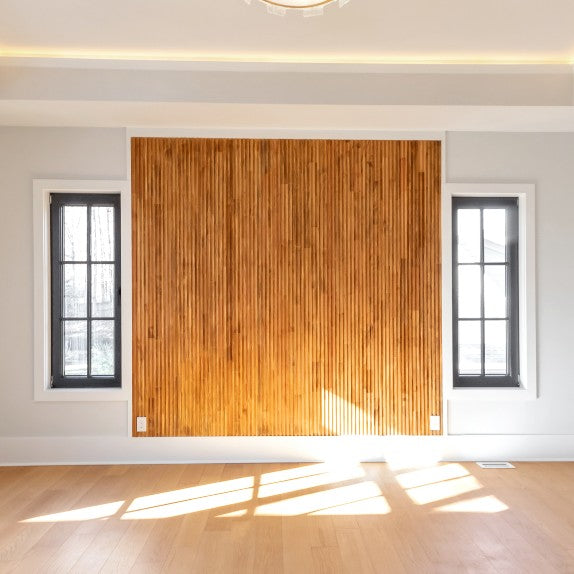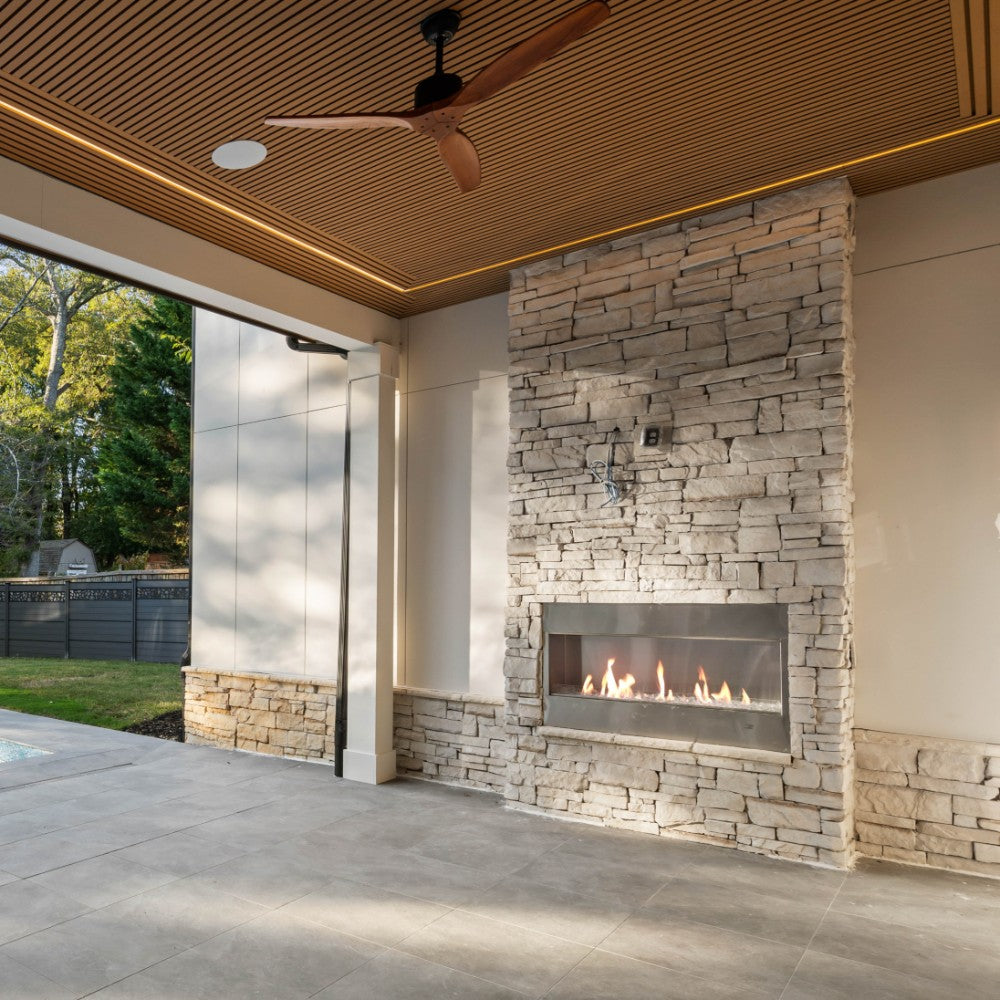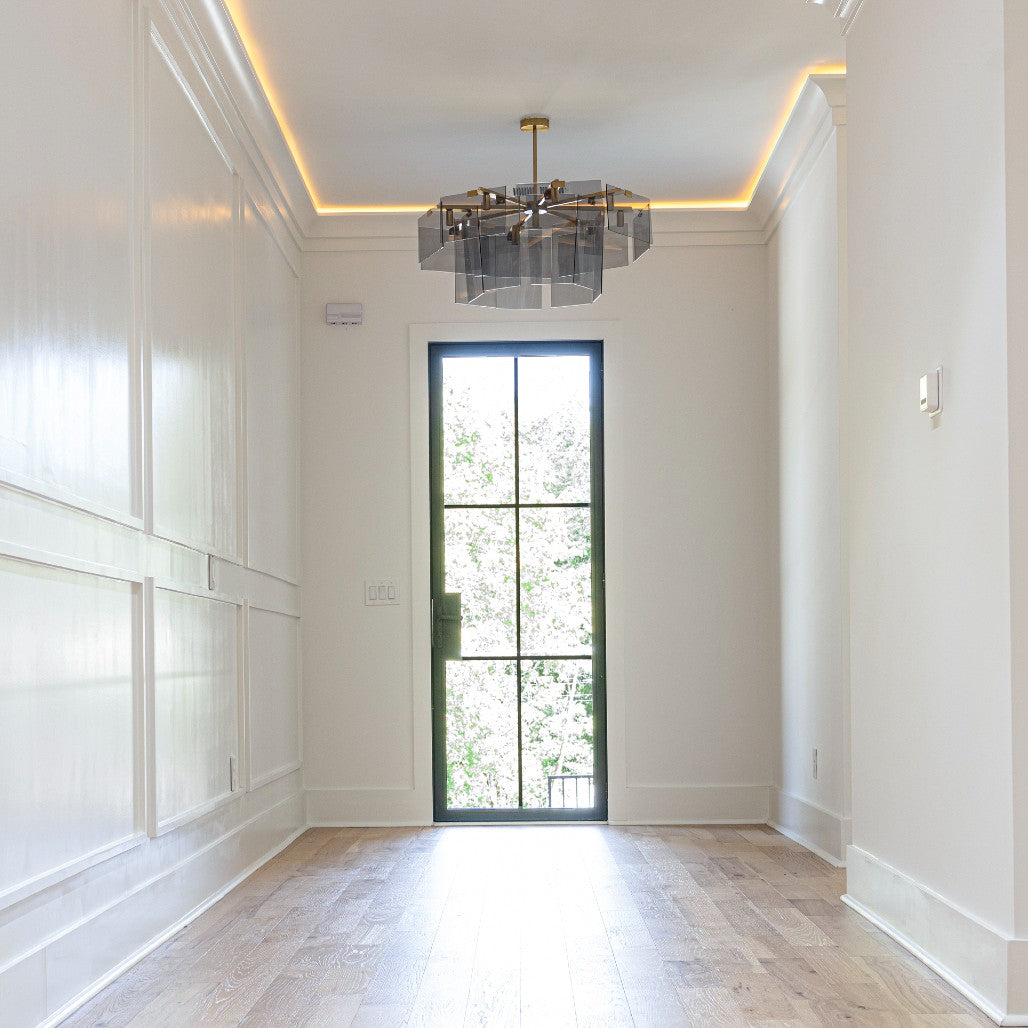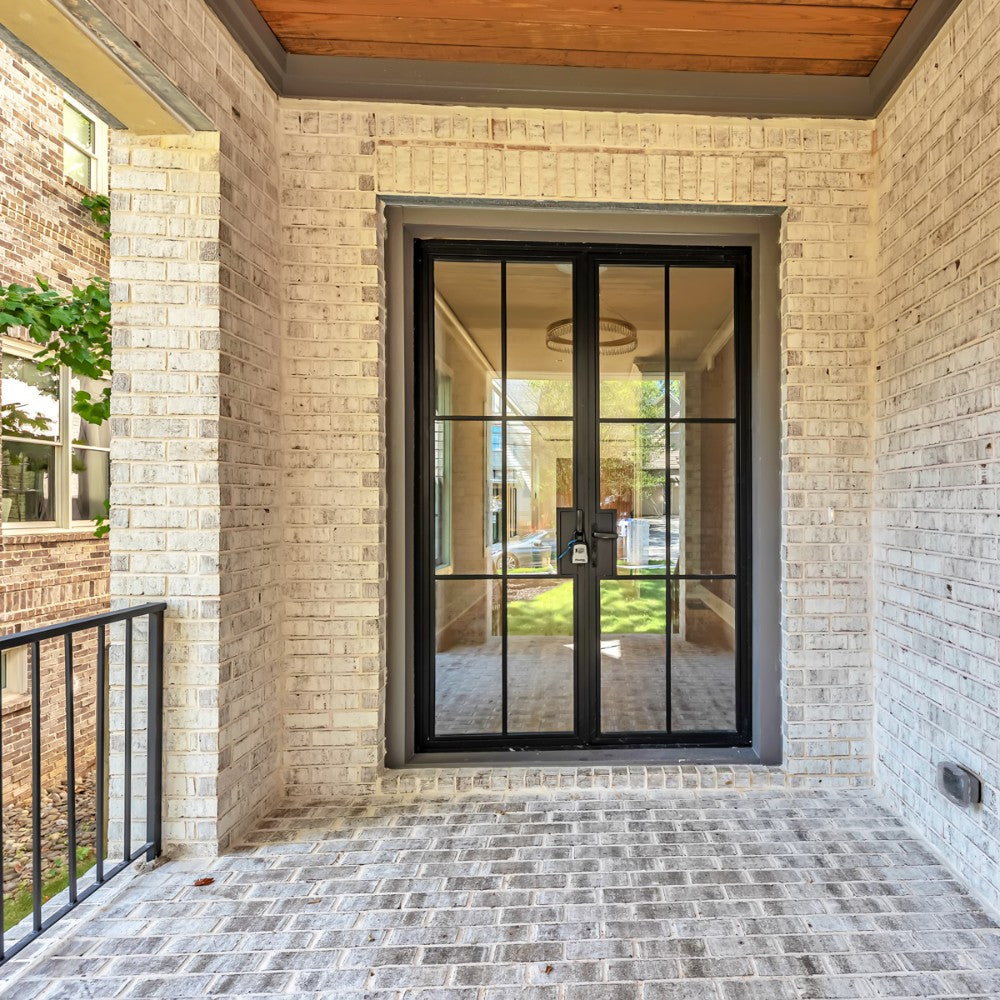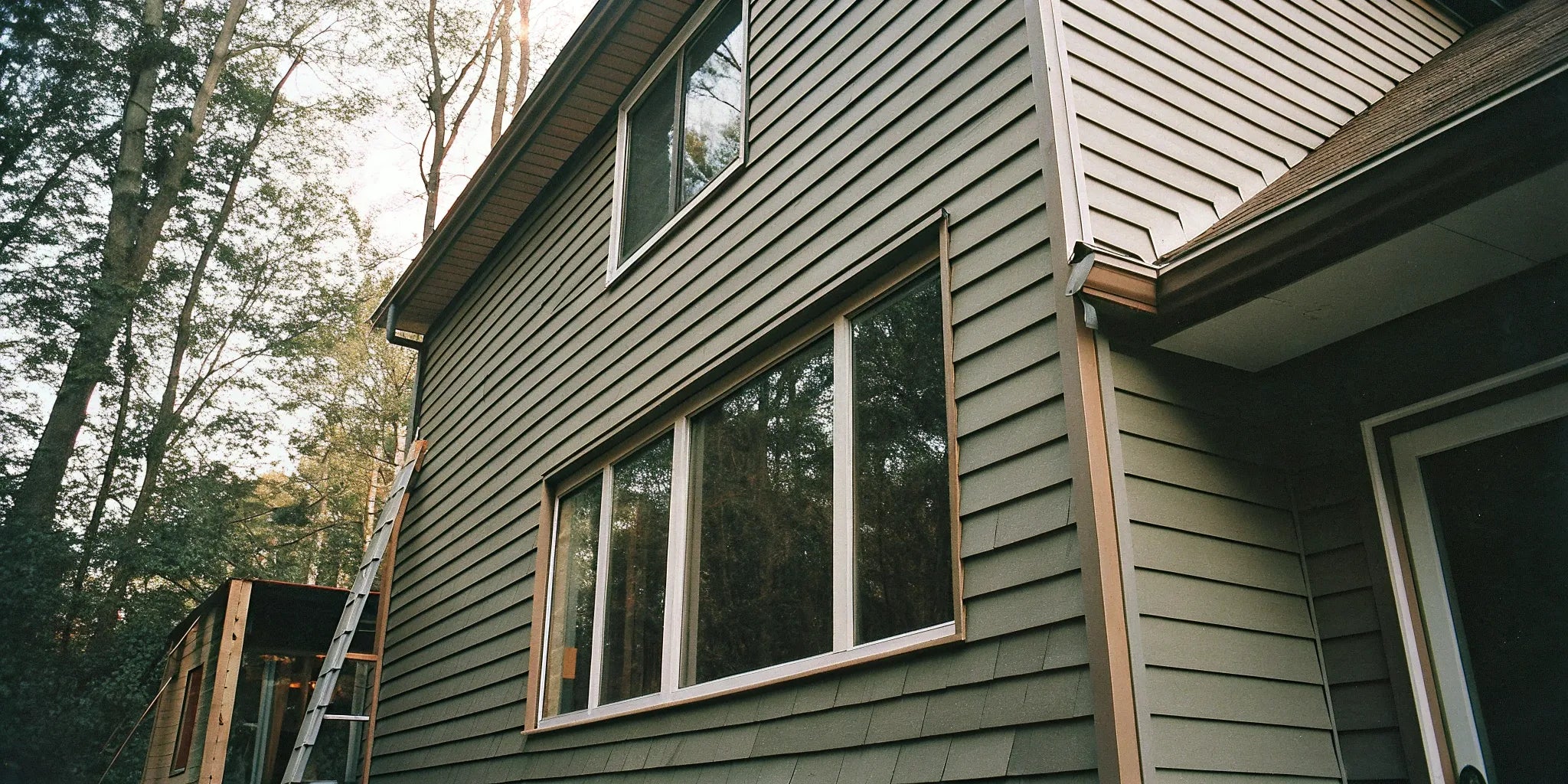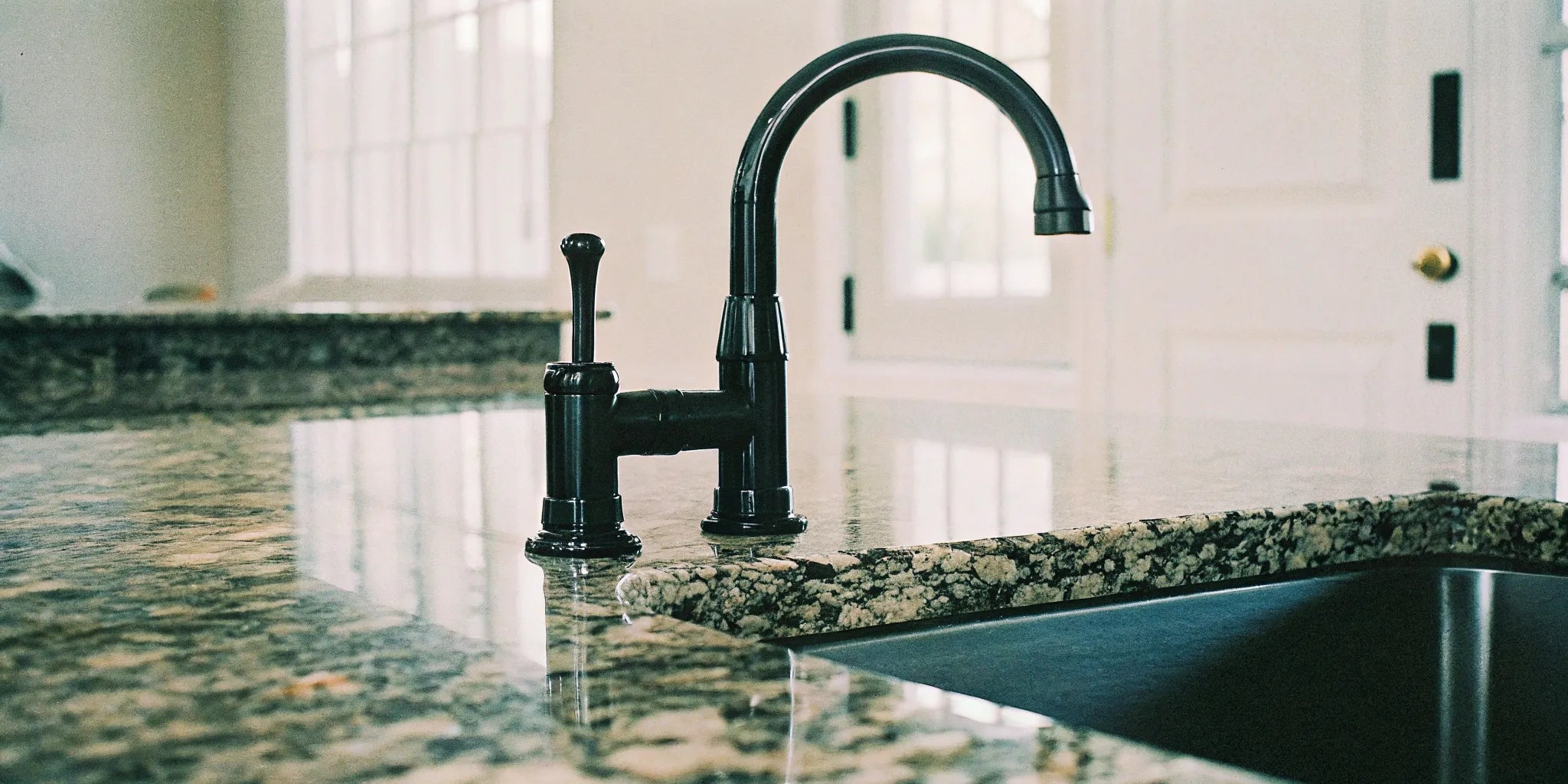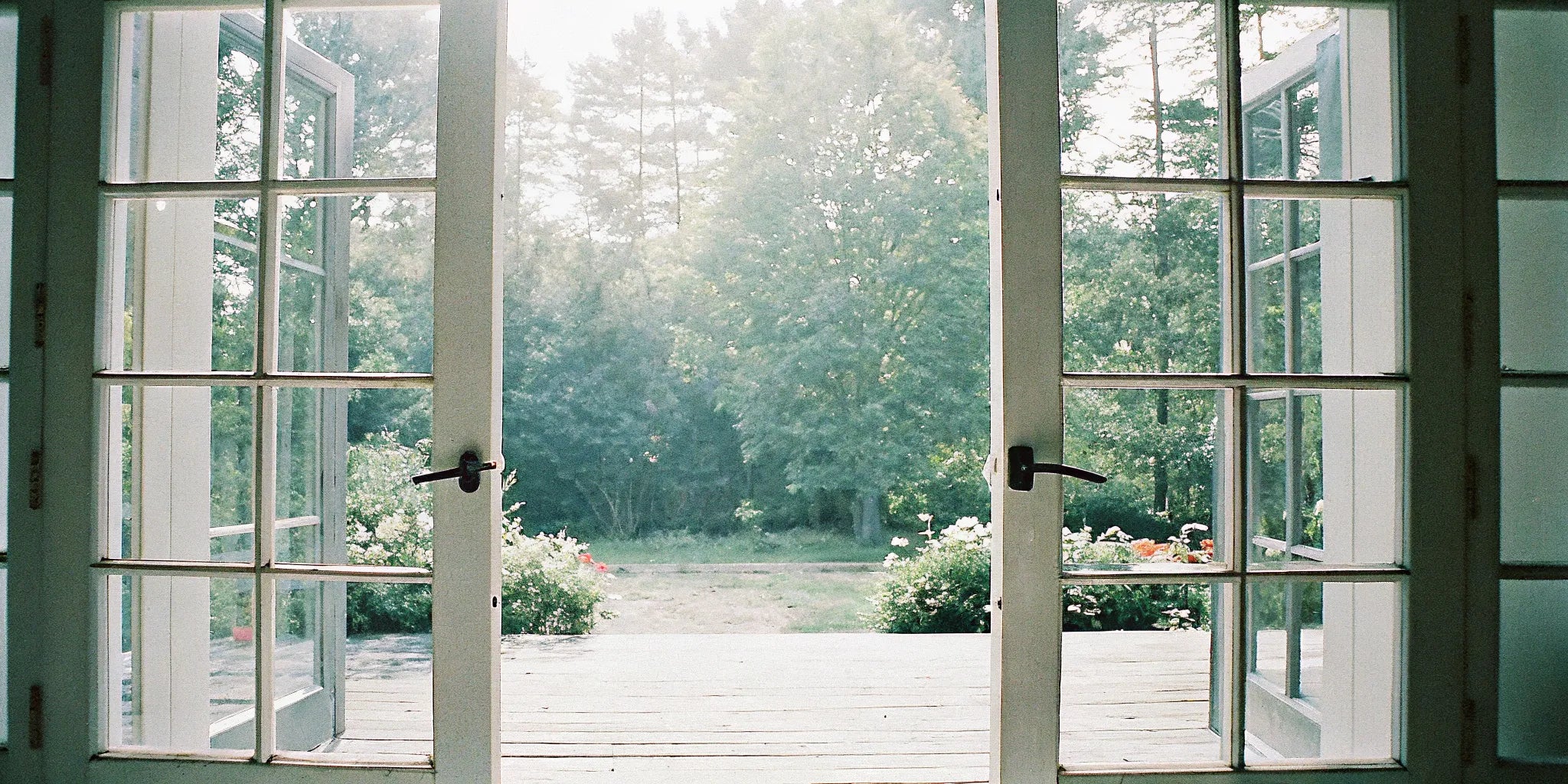
The Ultimate Exterior French Door Buyer's Guide
Shopping for an exterior French door can feel like you're trying to crack a secret code. Terms like "handing," "U-factor," and "astragal" can make a simple decision feel surprisingly complex. But knowing what you're looking for is the first step to getting your project right. This guide translates the technical jargon into plain English. We’ll walk through the important details like glass efficiency, locking systems, and weather resistance. You'll have the confidence to choose a door that fits your space, meets your needs, and looks exactly the way you want it to.
Key Takeaways
- A Perfect Fit is Non-Negotiable: The success of your outswing doors starts with the rough opening. Before you buy, confirm the opening is plumb, level, and sized correctly to ensure a smooth, secure, and weathertight installation.
- Look Beyond Style to Substance: While aesthetics matter, true value lies in performance. Prioritize features like durable steel frames, multi-point locking systems for security, and energy-efficient glass to ensure your doors are strong, safe, and insulating.
- Commit to Simple, Seasonal Upkeep: Protect your investment with a simple maintenance routine. Regularly cleaning the glass, inspecting weatherstripping for wear, and lubricating the hardware will keep your doors operating smoothly and looking great for years.
Your Guide to 72x80 Outswing Exterior French Doors
If you’re looking to create a stunning connection between your indoor and outdoor spaces, a 72x80 outswing exterior French door is a fantastic choice. Let's break down what that means. The "72x80" refers to the dimensions: 72 inches wide by 80 inches tall, a standard size that creates a generous, welcoming opening. The "outswing" part is key—it means the doors open outward, swinging onto your patio, deck, or balcony instead of into your room. This design is perfect for maximizing interior floor space, making it a smart solution for rooms where every square foot counts.
These doors are more than just a way to get outside; they're a design statement. They flood your home with natural light and offer an unobstructed view of your yard or garden, effectively blurring the line between inside and out. When you’re planning your project, thinking about how you use your space will help you decide if an outswing design is the right fit. For example, if your living room furniture would block an inward-swinging door, an outswing model is the perfect solution. They are a beautiful and practical upgrade for any home, blending classic style with modern functionality to create an entryway that is both impressive and highly usable.
Breaking Down the Dimensions and Specs
A 72x80 French door is a double-door system, with each door panel being roughly 36 inches wide. When opened, these doors create a wide, inviting entryway perfect for high-traffic areas like a patio or deck. One important detail to plan for is the swing space. A standard 72x80 outswing door requires about 15 square feet of clear space on the exterior. This ensures the doors can open fully without hitting furniture, railings, or planters. This size is ideal for creating a grand entrance that feels both spacious and elegant, making it a popular choice for primary access points to outdoor living areas.
Why Choose an Outswing Design?
The biggest advantage of an outswing door is that it saves valuable interior space. Instead of swinging into your living room or kitchen, the doors open outward, leaving your indoor layout completely untouched. This design also offers a security edge. Because the hinges are on the outside, they are built with special features like non-removable pins. This design detail prevents intruders from simply popping the hinge pins to remove the doors. While they sometimes require more robust hardware to handle the elements, the trade-off is a more secure and space-efficient entryway for your home.
When to Consider an Inswing Design
While outswing doors are fantastic space-savers, they aren't the right fit for every home. If you live in a climate with heavy snowfall, an inswing design is often the more practical choice. A major snowstorm can pile snow against your exterior, physically blocking an outswing door from opening. An inswing door guarantees you can always get out, no matter the weather. Limited outdoor space is another key consideration. If your patio or balcony is small, you don’t want doors eating into your usable area for seating or plants. Inswing doors also offer a distinct sense of security, as their hinges are located on the inside of your home, making them inaccessible to tampering from the outside.
Where Do They Work Best?
Outswing French doors are the perfect match for any room that opens onto a patio, balcony, or deck. They create a seamless transition that encourages an indoor-outdoor lifestyle, especially in homes with great views. For a successful installation, your contractor will need to prepare a rough opening that is plumb, level, and about an inch wider and taller than the door frame itself. This ensures a snug, weather-tight fit. When paired with matching steel windows, these doors can define the architectural style of your home while providing a secure, beautiful, and weather-resistant entryway.
Understanding French Door Options and Terminology
When you hear "French doors," you probably picture a classic pair of doors that open in the middle. While that’s a popular style, the world of French doors is much bigger and more customizable than you might think. Getting familiar with the different configurations and terms will help you choose the perfect doors for your project. It’s all about finding the right combination of style, function, and fit for your space. From single panels to grand entrances with extra glass, understanding your options is the first step toward making a confident decision. Let's walk through the key details you'll need to know before you start shopping.
Configurations Beyond the Standard Double Door
While the iconic double door is a beautiful choice, it's not your only option. French door style, characterized by its glass panes, can be adapted to fit various openings and architectural designs. You can find single French doors that offer the same light-filled aesthetic for smaller doorways, like a home office or pantry. For a more dramatic effect, you can flank your doors with sidelites—tall, narrow windows on either side—or add a transom window above the frame. These architectural additions create a stunning, cohesive entryway that maximizes natural light and makes any room feel more open and impressive.
Doors Without a Center Post
Yes, you can absolutely get French doors without a fixed center post, also known as an astragal. This design creates a completely unobstructed opening when both doors are open, which is incredibly convenient for moving large items like furniture or appliances. So, how does it work? One of the doors, called the passive door, is secured with hidden slide bolts or latches at the top and bottom of the frame. When you only need to walk through, you use the main, or active, door. But when you need the full width of the opening, you simply unlatch the passive door, giving you a wide, clear passage.
Swinging vs. Sliding French Doors
The next big decision is how your doors will operate. Traditional French doors swing open on hinges, either inward into the room or outward onto a patio. The direction you choose depends on your space and preference. As we discussed earlier, outswing doors are great for saving interior floor space. However, if you have limited clearance on your patio or deck, an inswing door might be a better fit. For spaces that are tight on both sides, a sliding French door is an excellent alternative. It gives you the classic multi-pane look but operates on a track, so it doesn't require any swing room at all.
Common Sizes and Dimensions
French doors come in a variety of standard sizes to fit common rough openings. A 72x80 door is a popular double-door dimension, but you'll find many other options. For instance, our steel door collection includes sizes like the 60x80 double door and taller 36x96 single doors for homes with higher ceilings. The numbers always refer to the width and height in inches. When planning, it’s crucial to measure your rough opening accurately. A precise measurement ensures you order the right size, which is fundamental for a smooth installation and a weathertight seal that will last for years.
Key Terminology: Handing and Active/Passive Doors
Getting the terminology right is essential, especially when placing an order. "Handing" refers to the direction the door swings open and is always determined from the outside looking in. To figure out the handing, stand outside facing the door. If the hinges are on the left and the door swings away from you, it's a left-handed door. For double doors, you'll also need to specify the "active" door—that's the one you'll use most often, which contains the primary lockset. The other door is the "passive" door, which remains stationary until you disengage its latches. Understanding these basic door terms will make your conversation with suppliers and contractors much clearer.
What to Look for in an Exterior French Door
When you’re choosing the perfect French doors, it’s easy to get caught up in the aesthetics—the color, the finish, the style. But the features you can’t always see are what make the biggest difference in performance and longevity. The right materials and construction will ensure your doors not only look great but also stand up to daily use, keep your home secure, and protect you from the elements. Let’s walk through the key components to look for so you can make a choice you’ll be happy with for years to come.
Which Frame Material is Right for You?
The frame is the backbone of your door, and its material directly impacts how long it will last. For exterior doors, you need something that can handle whatever the weather throws at it. Materials like steel are an excellent choice because they offer incredible strength and resistance to warping or cracking. Outswing French doors, in particular, require specialized, heavy-duty hardware to manage the force of wind and prevent sagging over time. Investing in a durable frame from the start means you’re choosing a door that will maintain its integrity and function smoothly for the long haul. When you explore options like steel doors, you're prioritizing a secure and lasting addition to your home.
Steel: For Maximum Durability and Security
If strength and security are at the top of your list, steel is the undisputed champion. Steel frames won’t warp, rot, or crack, even when exposed to harsh weather year after year. This incredible durability makes them a smart, long-term investment for any home. Beyond their resilience, steel doors provide an unmatched level of security, offering peace of mind that other materials simply can't replicate. Their clean lines and slim profiles also allow for larger glass panes, maximizing natural light without compromising on strength. For an exterior French door that delivers on performance, longevity, and modern style, steel is an excellent choice that stands the test of time.
Wood: For a Classic, Traditional Look
There’s no denying the timeless beauty of wood. A wooden French door brings a natural warmth and classic elegance to any home, creating a truly inviting entryway. The ability to stain or paint wood in any color offers endless customization to match your home’s unique style. However, this beauty comes with a commitment to maintenance. Wood is susceptible to the elements and can swell, warp, or rot if not properly sealed and regularly maintained. For homeowners who love the authentic look and don't mind the upkeep, wood remains a beautiful and traditional option that adds significant character and charm.
Fiberglass: A Low-Maintenance Alternative
Fiberglass doors offer a fantastic balance of good looks and practicality. They are designed to mimic the appearance of real wood, often featuring convincing grain textures, but without the demanding upkeep. Fiberglass is exceptionally durable and resistant to dents, scratches, and rust. It also stands up well to extreme temperatures and moisture, so you won’t have to worry about it warping or rotting over time. If you want the aesthetic of a classic wood door but prefer a low-maintenance solution that will look great for years with minimal effort, fiberglass is a strong contender worth considering.
Combination Materials: The Best of Both Worlds
Why choose one material when you can have the benefits of several? Combination, or "clad," doors are engineered to give you the best of both worlds. Typically, these doors feature a beautiful wood interior that adds warmth and style to your living space, combined with a durable, weather-resistant exterior cladding of aluminum or vinyl. This smart design protects the vulnerable wood from the elements, eliminating the need for constant painting and sealing. You get the classic look you love on the inside and a tough, low-maintenance shield on the outside, ensuring your doors remain beautiful and functional for the long haul.
Choosing Glass for Better Energy Efficiency
The large glass panes are what make French doors so beautiful, but they can also be a source of energy loss if you don’t choose wisely. To keep your home comfortable and your energy bills in check, look for glass with strong energy performance ratings. Pay attention to the U-factor, which measures insulation (lower is better), and the Solar Heat Gain Coefficient (SHGC), which indicates how well the glass blocks the sun’s heat (again, lower is better). For example, a door with a U-factor around 0.29 and an SHGC of 0.23 provides excellent insulation. These features are crucial for creating an energy-efficient home that stays cooler in the summer and warmer in the winter.
Keeping Your Home Safe: Locks and Security
Your exterior doors are a primary line of defense for your home, so security should be a top priority. A standard single-point lock might not be enough to give you complete peace of mind. Many modern outswing French doors come equipped with advanced locking systems that secure the door to the frame at multiple points—top, middle, and bottom. A 3-point locking mechanism, for instance, makes it significantly harder for anyone to force the door open. This integrated system provides a much higher level of security, helping you feel safe and protected. It’s a critical feature that turns a beautiful entryway into a secure one.
Addressing Common Vulnerabilities
It’s smart to think about potential weak points when choosing any exterior door. With outswing models, the most common questions are about the exposed hinges and large glass panels. Fortunately, modern designs are engineered to address these concerns head-on. High-quality outswing doors feature security hinges with non-removable pins, making it impossible for someone to tamper with them from the outside. To protect against forced entry, the combination of a strong frame and an advanced locking system is key. A durable steel frame paired with a 3-point locking mechanism creates a secure barrier, ensuring your beautiful doors are also a formidable defense for your home.
Will Your Doors Stand Up to the Elements?
A good exterior door does more than just open and close; it seals your home off from rain, wind, and drafts. High-quality weatherstripping and tight seals are essential for preventing leaks and improving energy efficiency. To ensure your doors continue to perform their best, a little maintenance goes a long way. Periodically clean the tracks and glass, inspect the seals for any signs of wear or cracking, and lubricate the hinges and locks. Taking these simple maintenance steps will protect your investment from the elements, prevent costly damage, and keep your doors operating just like new.
Comparing Brands and Understanding Costs
Once you know the features you need, it’s time to talk brands and budget. The market for French doors is broad, with options at nearly every price point. Understanding what drives cost and quality will help you find the perfect doors for your home. Let’s break down what you can expect.
Explore Our Top Picks at USA Builders Depot
At USA Builders Depot, we focus on high-quality, durable doors that offer exceptional value. Our steel doors are engineered for superior strength and security, making them a smart long-term investment. We know outswing doors need specialized hardware to handle the elements, so our products are built to last. This commitment means you get a door that performs reliably for years. For trade professionals, we also offer customized solutions and bulk pricing to meet your project needs.
How Top Brands Compare
As you shop, you’ll see brands like JELD-WEN and Masonite. Each has its own focus, from budget options to high-end custom designs. We provide a curated selection of premium doors that balance cost and quality. By working directly with us, you can find superior materials and construction without the typical big-box markup. Always compare materials and features side-by-side to see where the true value lies.
What Should You Expect to Pay?
Prices for 72x80 outswing French doors can range from under $600 to over $5,000. The difference comes down to frame material, glass type, and hardware quality. A basic steel door is more affordable than a custom aluminum one with impact-resistant glass. While a low price is tempting, a higher initial cost often means better energy efficiency and durability. Professionals looking for the best value can check out our trade program for exclusive pricing.
French Doors vs. Sliding Doors: A Cost Comparison
When you're deciding between French doors and sliding doors, budget is often a major factor. Generally, French doors come with a higher price tag, and the reason lies in their design and construction. Unlike a sliding door with one moving panel, a French door has two, which requires more complex and robust hardware to operate smoothly and securely. Think about it—you need two sets of hinges, handles, and a more intricate locking system. To ensure they remain aligned and weathertight over the years, they often feature specialized components like multi-point locks and heavy-duty, adjustable hinges. This hardware adds to the overall cost but is essential for the door's long-term performance and security.
How New Doors Can Impact Your Home's Value
Upgrading your exterior doors is more than just a cosmetic change; it's a smart investment in your home's value. A beautiful, high-quality set of French doors creates a powerful first impression and enhances curb appeal, which can be a major selling point. Real estate experts often note that premium features can significantly increase a home's perceived value. For instance, some studies suggest that quality brand-name doors can increase a home's value by a considerable margin. By choosing durable and secure options like our steel French doors, you're not just buying an entryway—you're adding a feature that pays for itself in both daily enjoyment and future resale value.
Understanding the Lifespan of Your Doors
An exterior door is an investment you expect to last, and with the right choice, it will. The lifespan of a French door depends heavily on its material and how well it's maintained. A high-quality door made from durable materials like steel can easily last between 15 and 30 years, and sometimes even longer. The key is proper care. Regular cleaning, inspecting the weatherstripping, and ensuring the hardware is in good working order will protect your door from the elements and prevent premature wear. Choosing a well-constructed door from the start is the most important step toward ensuring it will serve your home beautifully and reliably for decades to come.
What to Look for in a Warranty
A solid warranty shows the manufacturer stands behind its product. Look closely at the details: what’s covered and for how long? Different parts, like the glass and frame, might have separate warranty periods. Most warranties also require proper installation to be valid—the rough opening must be plumb, level, and correctly sized. Reading customer reviews can also give you a sense of a company’s commitment to quality and service.
Find Your Perfect Style
Once you’ve handled the technical specifications, it’s time for the fun part: choosing a design that reflects your personal taste and complements your home’s character. Exterior French doors are a significant architectural feature, and the right style choices can transform your entryway or patio connection from merely functional to truly stunning. The finish, glass, and hardware all work together to create a cohesive look. Let’s walk through how to select the perfect combination to make your doors a true centerpiece of your home’s design.
How to Choose the Right Finishes and Colors
The finish and color of your French doors set the tone for your home's exterior. Think about your existing color palette—siding, trim, and roofing—and decide whether you want your doors to blend in or stand out. Classic white or black offers timeless appeal, while a bold color can add a touch of personality. Our steel doors provide a durable, sleek foundation that can be finished to match any aesthetic. Steel is not only incredibly strong but also holds paint beautifully, giving you endless possibilities to create a custom look that lasts.
Finding the Perfect Glass Pattern
The glass in your French doors does more than just let in light; it’s a key design element. For an open, airy feel with unobstructed views, clear glass is a perfect choice. If privacy is a priority, consider frosted, reeded, or textured glass patterns that diffuse light while obscuring the view. For homes in storm-prone areas or for those seeking extra security, impact-resistant glass is an excellent option that adds a layer of protection without sacrificing style. The right glass can enhance both the beauty and functionality of your space, much like our modern steel windows do.
The Finishing Touch: Selecting Your Hardware
Hardware is the jewelry of your doors—it adds that final, polished touch. But it’s not just about looks; it’s also critical for security. Since outswing doors have exposed hinges, it’s essential to choose a set with secure, non-removable hinge pins to prevent intruders from gaining entry. Once security is covered, you can focus on style. Select handles, locks, and hinges in a finish that complements your home’s other exterior details. Try matching your hardware to your outdoor lighting for a cohesive and thoughtfully designed look.
Functional Features and Customizations
Beyond the foundational choices of material and style, modern French doors offer a range of functional upgrades that can significantly improve your daily life. These customizations are designed to add convenience, privacy, and a personal touch to your entryway. From letting in a cool breeze without welcoming insects to giving your furry friend their own entrance, these features allow you to tailor your doors perfectly to your household’s needs. Thinking through these options beforehand ensures you get a door that doesn’t just look good but works exactly how you need it to.
Screen Options for Fresh Air
One of the best parts of having French doors is the ability to open them wide and let fresh air circulate through your home. Of course, you don’t want to let in bugs along with the breeze. Screens are the perfect solution, and you have a few options depending on your door’s design. For the outswing doors we’ve been discussing, a screen that sits on the inside is the most practical choice. Many homeowners opt for retractable screens, sometimes called “phantom screens,” which roll away discreetly into a cassette when not in use. This gives you a completely unobstructed view when the doors are closed, maintaining the clean, elegant look of your entryway while providing a functional barrier when you need it.
Blinds-Between-the-Glass for Privacy
While large glass panes are beautiful, there are times when you need privacy. Blinds-between-the-glass are an ingenious solution that seals mini-blinds between the two panes of glass. This feature gives you complete control over light and privacy with a simple slider, and because the blinds are enclosed, they never get dusty or damaged. It’s a clean, low-maintenance alternative to traditional curtains or aftermarket blinds. This option is often paired with high-performance, energy-efficient glass, such as Low-E coatings, so you get the benefits of insulation and privacy all in one sleek package. It’s a practical upgrade that adds a touch of modern convenience to a classic door style.
Adding a Pet Door
For households with four-legged family members, a pet door can be a game-changer. Instead of getting up to open the door every time your dog or cat wants to go out, you can integrate a pet door directly into your French doors. Some manufacturers offer models with a pet door already installed, ensuring a perfect, weather-tight fit that doesn’t compromise the door’s structure or security. This is a far better option than attempting to cut into an existing door, which can void warranties and affect insulation. It’s a thoughtful customization that makes life easier for both you and your pets, seamlessly blending convenience into your home’s design.
How to Match Your Home's Architecture
Your French doors should feel like a natural extension of your home’s architectural style. A modern home might call for doors with clean lines and large glass panes, while a traditional or farmhouse-style home may look best with doors that have multiple divided lites. Keep in mind that outswing doors often require more robust, weather-resistant hardware, which can influence the cost. However, this investment ensures your doors will stand up to the elements while enhancing your home’s curb appeal. Consider how the door style will pair with other exterior materials, like our exterior wall panels, to create a harmonious facade.
What to Know Before You Install
You’ve picked out the perfect doors, and you’re ready to see them in your home. But before you or your contractor get to work, a little preparation can make the entire installation process smoother and ensure your doors function beautifully for years. Taking the time to get the details right at this stage prevents frustrating issues down the road, from drafts to doors that just don’t close correctly. Think of it as setting the foundation for a flawless finish. Here’s what you need to consider before you begin the installation.
Preparing for Installation
The single most important step for a successful door installation is preparing the rough opening. This is the unfinished hole in the wall where your new French doors will live. For the best results, the opening needs to be plumb (perfectly vertical), level (perfectly horizontal), and square. According to the experts at This Old House, the opening should also be about an inch wider and taller than the door's frame. This extra space allows for adjustments and ensures the door unit fits perfectly, operates smoothly, and seals tightly against the elements. Taking precise measurements and correcting any issues with the opening beforehand will save you a major headache.
DIY vs. Hiring a Pro
Deciding whether to install the doors yourself or hire a professional is a big decision. If you have significant carpentry experience, a DIY installation is certainly possible. However, exterior French doors come with unique challenges. For instance, outswing doors require specific security measures, like securing the hinge pins to prevent intruders from removing them. A professional installer understands these nuances and can guarantee your doors are not only beautiful but also secure and weathertight. If you’re working with a contractor, our trade program offers benefits that can help your project run smoothly. When in doubt, bringing in a pro is a worthwhile investment.
Typical Installation Timeline
So, how much time should you set aside for installation day? For a professional installer working with a perfectly prepared opening, a standard 72x80 French door unit can often be installed in just a few hours. However, the total installation time can vary quite a bit. The biggest factor is the condition of your existing opening. If the frame isn't plumb, level, or square, your contractor will need to make adjustments, which adds time. Removing the old door, dealing with any unexpected rot or damage, and the complexity of the door design itself can also extend the project. It's always a good idea to discuss the timeline with your installer beforehand so you know exactly what to expect.
Common Installation Problems (and How to Fix Them)
Even with careful planning, you can run into a few common issues. One of the most frequent problems with French doors is a gap developing between them over time. This isn't just a cosmetic issue; a gap can let in drafts, reducing your home's energy efficiency and comfort. As noted in a guide to French door challenges, this often stems from the initial installation. Ensuring the unit is perfectly square and securely fastened from the start is the best way to prevent this. Other potential hurdles include doors that stick or don't latch properly, which almost always trace back to an improperly prepared opening.
Preventing Air Leaks Over Time
Even the best-installed French doors can develop small air leaks as your home settles and the doors endure seasonal changes. The key to a draft-free home is consistent, simple upkeep. High-quality weatherstripping is your first line of defense, but it needs a little attention to do its job long-term. Make it a habit to inspect the seals around your doors a couple of times a year, especially as the seasons change. Look for any signs of cracking, peeling, or compression. Some experts even warn that doors can shift slightly and may need minor adjustments every year or two to maintain a perfect seal. A little maintenance, like cleaning the tracks and lubricating the hinges, goes a long way in keeping your doors operating smoothly and sealing tightly against the elements.
Why You Need to Check Local Building Codes
Before you finalize your purchase or start the installation, it’s essential to check your local building codes. These regulations exist to ensure safety and performance, especially for exterior doors that face the elements. Codes can dictate requirements for weatherproofing, wind resistance, and even the type of hardware you need. For example, outswing doors often need specialized hardware to withstand outdoor conditions and ensure they are fully weatherproof. A quick call or visit to your local building department’s website can clarify the rules in your area, ensuring your project is compliant from day one. Our high-quality steel doors are built to meet rigorous standards, giving you a great starting point.
How Secure and Durable Are Your Doors?
A beautiful door is one thing, but a door that protects your home from intruders and the elements is what truly matters. When you’re shopping for exterior French doors, performance and security should be at the top of your checklist. These features determine how safe your home is, how comfortable it feels, and even how much you spend on energy bills. Let’s break down the key performance indicators to look for so you can make a choice that gives you total peace of mind.
What is a Multi-Point Locking System?
Your door’s first job is to keep your home secure. A standard lock secures the door at a single point, but a multi-point locking system is the gold standard for exterior doors. Instead of one deadbolt, these systems engage at several points along the door frame—top, middle, and bottom. This makes the door significantly harder to force open, providing a serious upgrade in security. When you’re comparing options, look for doors that feature at least a 3-point locking system. It’s a small detail that makes a huge difference in protecting your home and family. High-quality steel doors often come standard with this feature.
How Well Do They Protect from Weather?
Outswing French doors face the full force of Mother Nature, so they need to be built tough. Look for doors designed with robust weatherstripping and tight seals to prevent drafts and water from getting inside. The hardware should also be rated for exterior use to resist rust and corrosion. A critical but often overlooked component is the sill pan, which is installed underneath the door to catch and drain away any water that might seep through. Even a tiny leak can lead to rot and mold over time, so ensuring your door is properly sealed and installed is essential for long-term durability.
What Do Thermal Ratings Mean?
A door’s thermal performance measures how well it prevents heat from passing through. This is crucial for maintaining a comfortable indoor temperature and keeping your energy bills in check. You’ll see two key ratings: the U-factor, which measures heat loss (lower is better), and the Solar Heat Gain Coefficient (SHGC), which measures how much solar heat the door blocks (lower is better in hot climates). For example, a door with a U-factor of 0.29 and an SHGC of 0.23 offers excellent insulation. Investing in a door with strong thermal performance ratings means your home stays warmer in the winter and cooler in the summer.
Do You Need Impact-Resistant Doors?
If you live in an area prone to hurricanes or severe storms, impact-resistant doors are a must-have. These doors are engineered with reinforced frames and laminated or tempered glass that can withstand high winds and impacts from flying debris. This feature not only protects your home during a storm but also adds an extra layer of security against break-ins. While it may add to the initial cost, the protection and safety it provides are invaluable. Many modern steel windows and doors offer impact-resistant glass as an option, so be sure to ask about it.
How to Care for Your New Doors
Your new exterior French doors are a significant investment in your home’s beauty and security. A little routine maintenance will ensure they look and function their best for years to come, protecting them from the elements and daily wear. Setting aside a small amount of time each season for upkeep can prevent bigger issues down the road and keep your entryway looking pristine. Think of it as simple preventative care that preserves the character and performance of your beautiful new doors.
How to Clean Your Exterior French Doors
Keeping your doors clean is the first step to long-term durability. For the glass panes, a simple solution of mild dish soap and water is usually all you need. Wipe them down with a soft, lint-free cloth and squeegee for a streak-free shine. For the door frame and panels, use the same gentle cleaning solution, being sure to rinse with clean water and dry thoroughly. This prevents dirt and grime from building up, which can degrade the finish over time. For extra protection against the elements, you can even apply a rain repellent to the exterior glass to help water bead up and roll away.
How to Maintain Seals and Weatherstripping
The weatherstripping around your French doors is crucial for energy efficiency, as it creates a seal that keeps drafts, moisture, and dust out. At least twice a year, take a moment to inspect the seals for any signs of cracking, peeling, or compression. Clean the weatherstripping with a damp cloth to remove any debris that could compromise the seal. If you notice any sections that are brittle or damaged, it’s important to replace them promptly. Maintaining a tight seal not only keeps your home comfortable but also helps lower your energy bills by preventing conditioned air from escaping.
How to Keep Hardware Working Smoothly
The handles, locks, and hinges on your doors get a lot of use, so they deserve some attention, too. Start by wiping down all the metal fixtures with a clean, damp cloth to remove fingerprints and grime. Check that all screws on the handles and hinge plates are tight, as they can loosen over time. Once a year, apply a silicone-based lubricant to the hinges and the moving parts of the locking mechanism. This simple step ensures your doors will continue to open and close smoothly and quietly, preventing unnecessary strain on the hardware.
A Seasonal Maintenance Checklist
A seasonal check-in is a great way to stay on top of door maintenance. In the spring and fall, give your doors a thorough cleaning, inspect the weatherstripping, and lubricate the hardware. It’s also the perfect time to check the paint or stain finish. Look for any chips, cracks, or faded areas that might need a touch-up to protect the underlying material from moisture. Before winter arrives, do one last check of the seals to ensure they’re ready to block cold drafts. Regular upkeep is the key to preserving the lasting beauty and performance of your exterior steel doors.
Ready to Buy? Your Final Checklist
Feeling ready to make a choice? That’s great! But before you click “add to cart,” let’s walk through a few final steps to make sure your purchase and installation go off without a hitch. A little planning now saves a lot of headaches later. This checklist covers the practical details—from measuring your space to setting a realistic budget—so you can feel completely confident in your decision.
How to Measure Correctly
Getting the measurements right is the most critical first step. Before you fall in love with a specific door, grab your tape measure. You’ll need to measure the rough opening—the space in the wall where the door will sit. For a smooth installation, this opening should be about one inch wider and one inch taller than the door's actual frame. Also, check that the opening is plumb (perfectly vertical) and level (perfectly horizontal). Taking the time to get precise measurements ensures your beautiful new doors will fit perfectly and operate smoothly from day one.
What to Expect on Delivery Day
Once you’ve chosen your doors, think about the logistics of getting them to your home. How will they arrive? At USA Builders Depot, we offer fast nationwide shipping to bring your materials directly to your job site or doorstep, which simplifies the process. When you order, confirm the delivery timeline so you can plan accordingly, especially if you’re coordinating with a contractor. Knowing when to expect your delivery helps you prepare the space and ensures someone is available to receive it, keeping your project on schedule.
How to Schedule Your Installation
Proper installation is key to both the security and performance of your outswing French doors. If you’re hiring a professional, share the door’s specifications with them ahead of time. For outswing doors, it’s especially important to discuss security features, like using hinge pins that can’t be easily removed by an intruder. This is a small detail that makes a big difference in securing your home. Coordinating these specifics with your installer beforehand ensures they have the right tools and knowledge for the job.
How to Set a Realistic Budget
Exterior French doors come in a wide range of price points, from a few hundred to several thousand dollars, depending on the material, glass, and features. It’s helpful to set a clear budget before you start shopping. This will help you narrow your options and focus on the doors that offer the best value for your investment. Remember to factor in the cost of hardware, delivery, and professional installation if you’re not doing it yourself. Our collection of steel doors offers durable and stylish options to fit various budgets without compromising on quality.
Related Articles
Frequently Asked Questions
Are outswing doors secure since the hinges are on the outside? This is a very common and smart question. It might seem like exposed hinges are a weak point, but high-quality outswing doors are designed specifically to address this. They are built with security features like non-removable hinge pins and studs that prevent the door from being lifted off its frame, even if the hinge pins are tampered with. When you pair this with a multi-point locking system, you get an entryway that is incredibly secure.
Why should I choose a steel French door over a wood or fiberglass one? While wood is classic and fiberglass is lightweight, steel offers an unmatched combination of strength and durability. Steel doors won't warp, crack, or rot the way wood can, making them a fantastic low-maintenance choice for any climate. They provide superior security and are an excellent foundation for a beautiful, long-lasting finish, giving you peace of mind without sacrificing style.
How much clear space do I really need on my patio for these doors to open? Planning your outdoor space is key. Since each of the two door panels is about 36 inches wide, you’ll need to ensure you have at least three feet of clear, unobstructed space extending outward from the doorway. This allows each door to swing open a full 90 degrees without hitting your patio furniture, planters, or railings, ensuring you can use the full, wide opening.
What is the most important factor for ensuring my new doors don't leak or feel drafty? A perfect, weather-tight fit comes down to the installation. While a quality door with robust weatherstripping is the starting point, none of it matters if the door isn't installed correctly. The rough opening must be perfectly plumb, level, and square to create a tight seal. This is why hiring an experienced professional is often the best investment you can make for ensuring your doors perform flawlessly for years.
Can I paint my steel French doors to match my home's exterior? Absolutely. That’s one of the great things about steel—it provides a smooth and stable surface that’s perfect for painting. You can easily customize the color to either blend with your home’s trim or create a bold, welcoming statement. Just be sure to properly prep the surface and use a high-quality exterior-grade paint to get a durable finish that will stand up to the elements.


